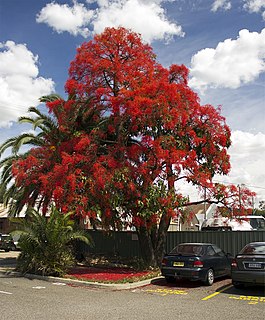
Brachychiton is a genus of 31 species of trees and large shrubs, native to Australia, and New Guinea. Fossils from New South Wales and New Zealand are estimated to be 50 million years old, corresponding to the Paleogene.
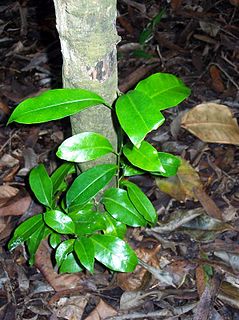
Fontainea is a genus constituting part of the plant family Euphorbiaceae. The nine currently known species grow naturally in Queensland (Qld) and New South Wales (NSW) Australia, New Caledonia and Vanuatu, and Papua New Guinea. Some species are commonly named blushwood.

Brachychiton acerifolius is a large tree of the family Malvaceae endemic to tropical and subtropical regions on the east coast of Australia. It is famous for the bright red bell-shaped flowers that often cover the whole tree when it is leafless. It is commonly known as the flame tree, Illawarra flame tree, lacebark tree, or kurrajong.

Pandorea is a genus of nine species of flowering plants in the family Bignoniaceae and is native to Australia, Malesia, New Guinea and New Caledonia. Plants in the genus Pandorea are mostly woody climbers with imparipinnate leaves arranged in opposite pairs, flowers in groups with tube-shaped flowers, and winged seeds.

Brachychiton rupestris, commonly known as the narrow-leaved bottle tree or Queensland bottle tree, is a tree in the family Malvaceae native to Queensland, Australia. Discovered and described by Sir Thomas Mitchell and John Lindley in 1848, it gained its name from its bulbous trunk, which can be up to 3.5 metres (11 ft) diameter at breast height (DBH). Reaching 10–25 metres (33–82 ft) high, the Queensland bottle tree is deciduous, losing its leaves between September and December. The leaves are simple or divided, with one or more narrow leaf blades up to 11 centimetres (4 in) long and 2 centimetres (0.8 in) wide. Cream-coloured flowers appear from September to November, and are followed by woody boat-shaped follicles that ripen from November to May. No subspecies are recognised.

Grevillea wilsonii, also known as Wilson's grevillea or native fuchsia is a shrub that is endemic to south western parts of Western Australia.

Grevillea manglesii is a shrub which is endemic to an area around Perth in Western Australia. It usually grows to around 3 metres in height and 4 metres in width and produces white flowers throughout the year.
Melaleuca penicula is a plant in the myrtle family, Myrtaceae and is endemic to the south of Western Australia. It is a rare species only known from the Fitzgerald River National Park and resembles Melaleuca eximia with its spikes of red flowers but its leaves and stamen bundles are different.

Brachychiton gregorii, commonly known as the desert kurrajong, is a small tree of the genus Brachychiton found in northern and western Australia. It was originally classified in the family Sterculiaceae, which is now within Malvaceae.

Melaleuca halophila is a plant in the myrtle family, Myrtaceae and is endemic to the south of Western Australia. It is a prickly shrub, similar to Melaleuca thapsina but its flowers are white and the leaves are shorter and hairier.
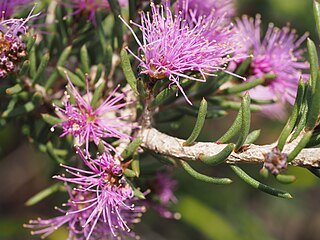
Melaleuca papillosa is a plant in the myrtle family, Myrtaceae and is endemic to the south-west of Western Australia. It is one of the smallest species of Melaleuca, distinguished by its narrow, usually hairy, pimply leaves, small heads of pink to purple flowers surrounded by silky hairs and scattered rather than clustered fruits.
Adenanthos dobagii, commonly known as Fitzgerald woollybush, is a shrub in the family Proteaceae. It grows to a mere 50 cm high, with crowded small silvery leaves and insignificant pink or cream flowers. It occurs only in southwestern Australia, where it is found in Fitzgerald River National Park on the south coast.

Amyema benthamii, commonly known as the twin-leaved mistletoe or Bentham's mistletoe, is a species of flowering plant, an epiphytic hemiparasitic plant of the family Loranthaceae native to Western Australia and the Northern Territory of Australia in semi-arid woodland. This species is named in honour of the English botanist George Bentham who between 1863 and 1878 published Flora Australiensis, the first flora of Australia.
Brachychiton compactus is a tree of the genus Brachychiton found in northeastern Australia. It is only found in the vicinity of Proserpine in Central Queensland.
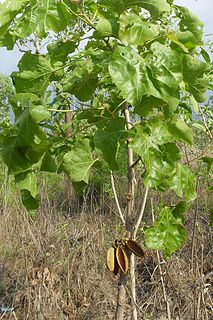
Brachychiton megaphyllus, commonly known as the red-flowering kurrajong, is a tree of the genus Brachychiton found in northern Australia.
Brachychiton spectabilis is a tree of the genus Brachychiton found in northern Australia. It was described by Gordon Guymer in 1988.

Melaleuca incana, commonly known as grey honey-myrtle, is a plant in the myrtle family, Myrtaceae and is endemic to the south-west of Western Australia and is naturalised in the south of Victoria in Australia. It is commonly grown as a garden plant and produces large numbers of white or creamy yellow flowers, sometimes highly scented, in spring.
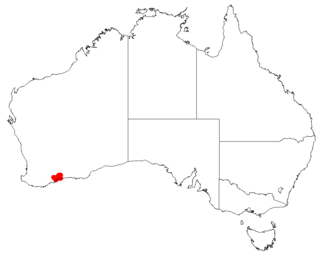
Persoonia dillwynioides, commonly known as Fitzgerald persoonia, is a species of flowering plant in the family Proteaceae and is endemic to a restricted area in the south-west of Western Australia. It is an erect, spreading shrub with smooth bark, linear leaves and bright yellow flowers borne singly or in groups of up to four along a rachis up to 3 mm (0.12 in) long.
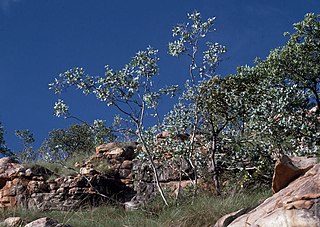
Eucalyptus mooreana, commonly known as Moore's gum, mountain white gum or King Leopold Range mallee, is a species of stunted, straggly tree or mallee that is endemic to the Kimberley region of Western Australia. It has smooth, powdery white bark, a crown of juvenile, sessile, stem-clasping leaves arranged in opposite pairs, flower buds arranged in groups of seven, white flowers and cup-shaped to hemispherical fruit.
Cyperus viscidulus is a sedge of the family Cyperaceae that is native to north western Australia.














